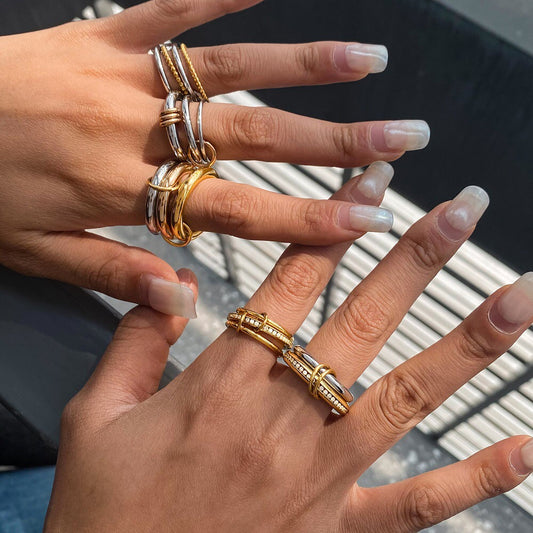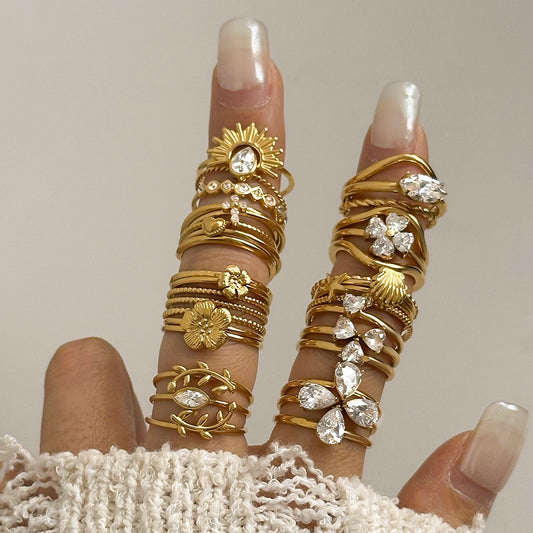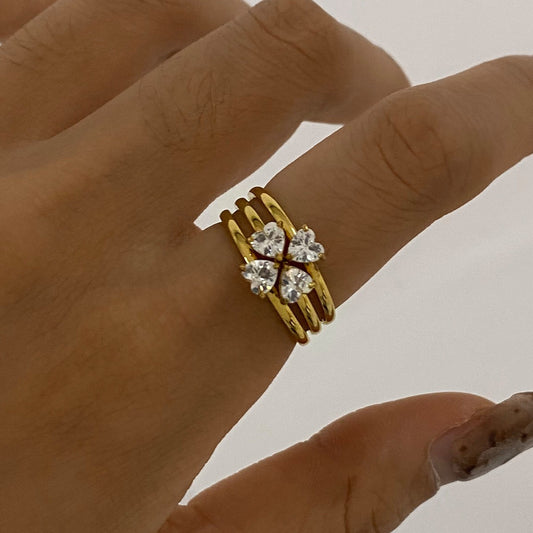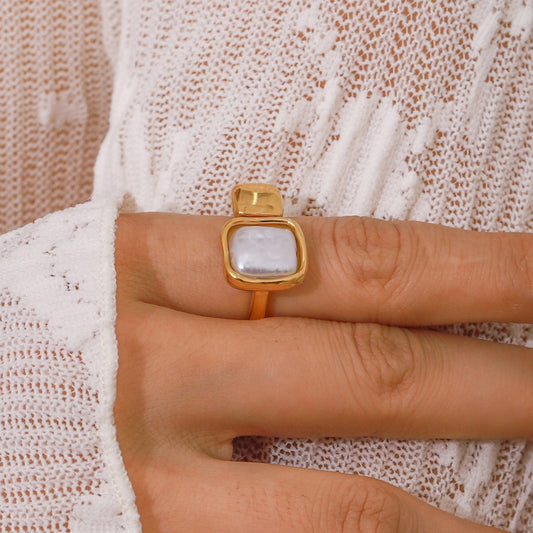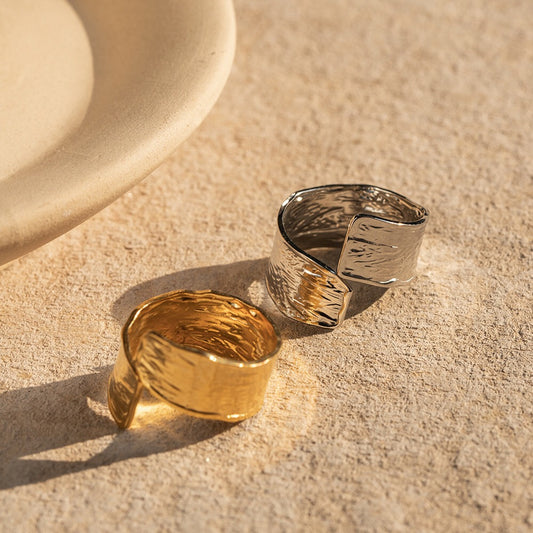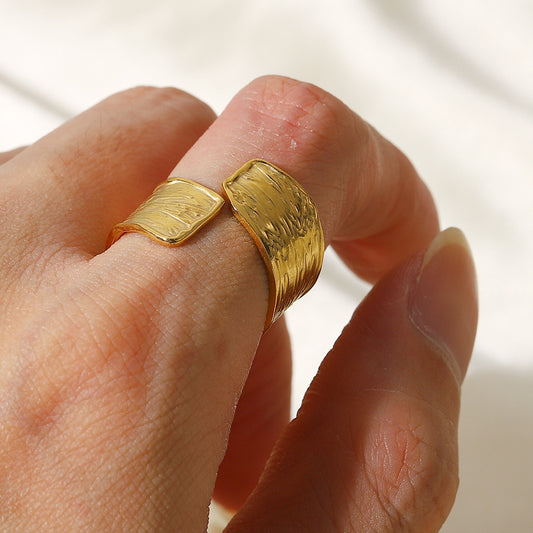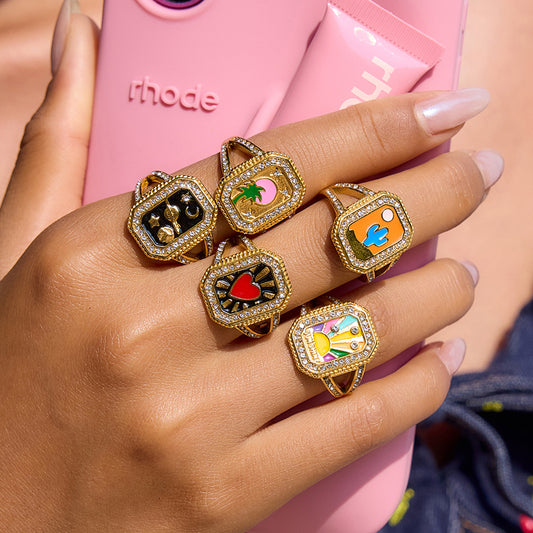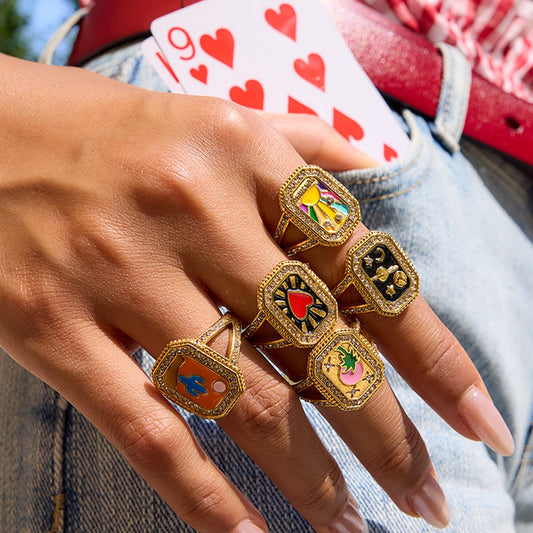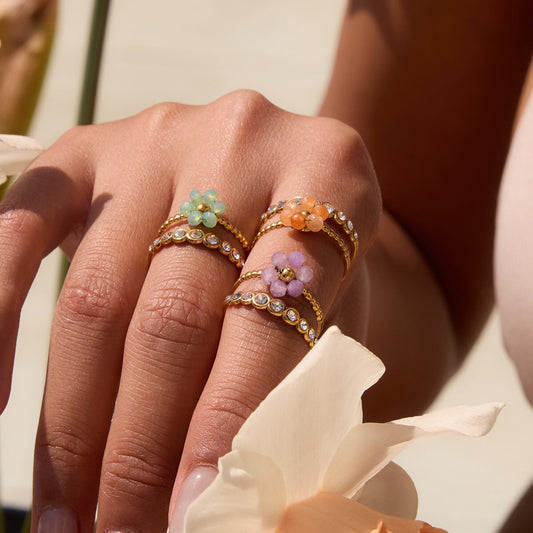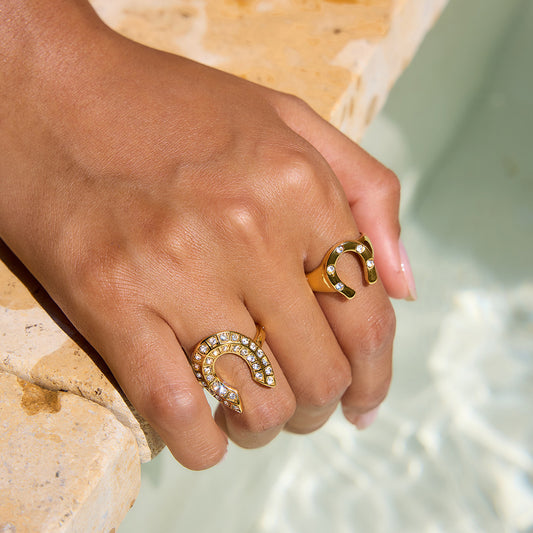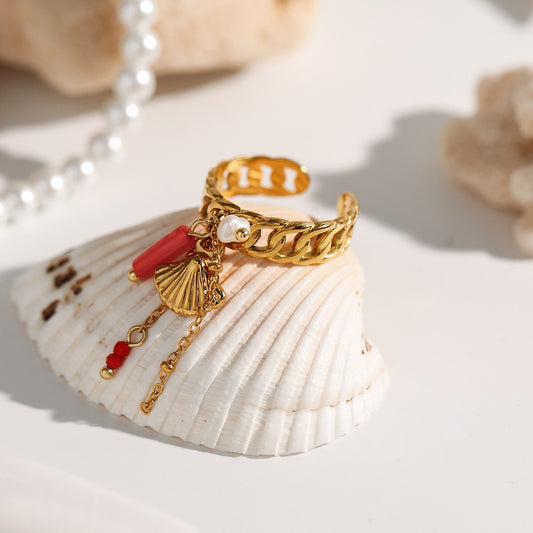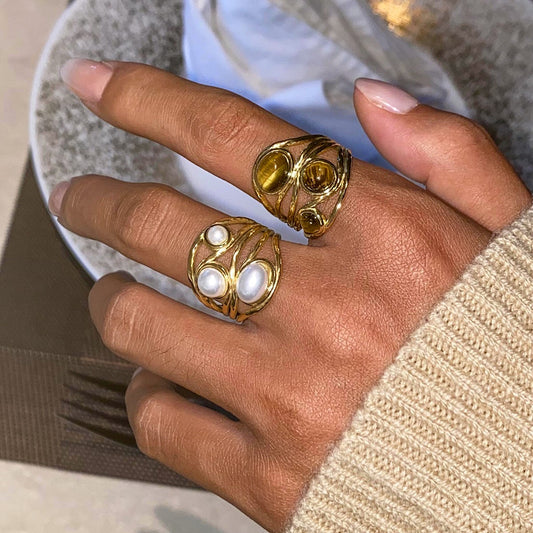Signet rings have been a symbol of identity, legacy, and style for millennia—and their popularity shows no signs of slowing down. According to the 2024 Global Fine Jewelry Report, searches for “signet rings” have increased by 91% year-over-year globally, with 72% of buyers citing “personal meaning” as the top reason for purchase. The ring jewelry market is a substantial part of the overall jewelry market, with the U.S. ring segment alone capturing over 43% of the total U.S. jewelry market, which was valued at $78.40 billion in 2024. Unlike generic jewelry, a signet ring is deeply personal: it can bear initials, family crests, or meaningful symbols that tell a story about who you are. From ancient kings using them as seals to modern professionals wearing them as everyday accessories, signet rings have evolved into a timeless piece that balances tradition and individuality. Below, we explore everything you need to know about signet rings—from their definition to styling tips, gifting ideas, and cultural significance.

What Are Signet Rings?
A signet ring is a type of ring characterized by a flat, engraved surface (usually on the bezel, or top) that was historically used to stamp wax seals on documents, letters, or parcels. Today, it’s primarily worn as a symbolic accessory, with the engraved design serving as a personal marker of identity, family, or values.
Core Design Features
-
Bezel Shape: The top (where the engraving sits) is typically oval, rectangular, or round—oval is the most classic and versatile shape.
-
Engraving Options: Traditional designs include family crests, monograms (initials), or coats of arms; modern styles often feature symbols (e.g., stars, hearts, animals), dates, or even minimalist patterns.
-
Metal Types: Common metals include sterling silver (affordable and versatile), gold (14k or 18k, for luxury), rose gold (trendy and warm), and platinum (durable and premium).
-
Band Style: Bands can be thick (for a bold look) or thin (for subtlety), with options like plain, textured, or engraved sides to add extra detail.
Historical Context
Signet rings date back to ancient civilizations: the Egyptians used them as seals for official documents around 3000 BCE, while the Romans wore them to signify social status and citizenship. In medieval Europe, they became a staple of nobility—each family had a unique crest engraved on their signet ring, used to authenticate letters and legal papers. By the 19th century, they evolved into a fashion accessory, and today, they’re beloved for their blend of history and personalization.
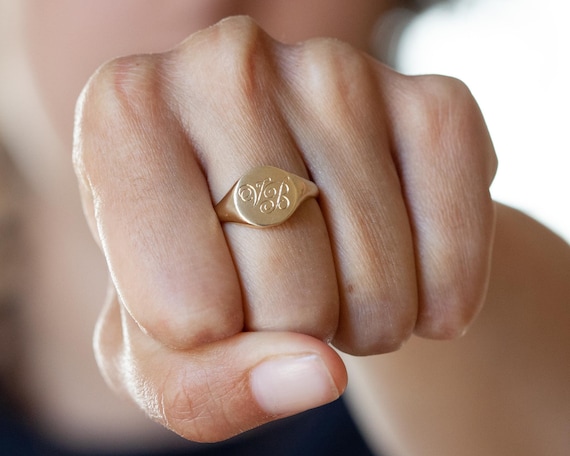
Why Is Signet Rings So Popular?
The resurgence of signet rings in modern jewelry stems from their unique ability to combine tradition, personalization, and versatility—making them a favorite among style lovers and those seeking meaningful accessories.
Deeply Personal Symbolism
Unlike mass-produced jewelry, a signet ring is tailored to the wearer. Whether it’s engraved with your initials, a family crest passed down through generations, or a symbol that represents a milestone (e.g., a wedding date, a child’s name), it tells a story. This personal touch makes it feel more like a “heirloom in the making” than just a ring.
Timeless Style That Transcends Trends
Signet rings have been in style for thousands of years—and for good reason. Their simple, structured design fits seamlessly with both vintage and modern aesthetics. You can wear a gold signet ring with a tailored suit for work, or a silver one with jeans and a t-shirt for brunch—its versatility ensures it never feels outdated.
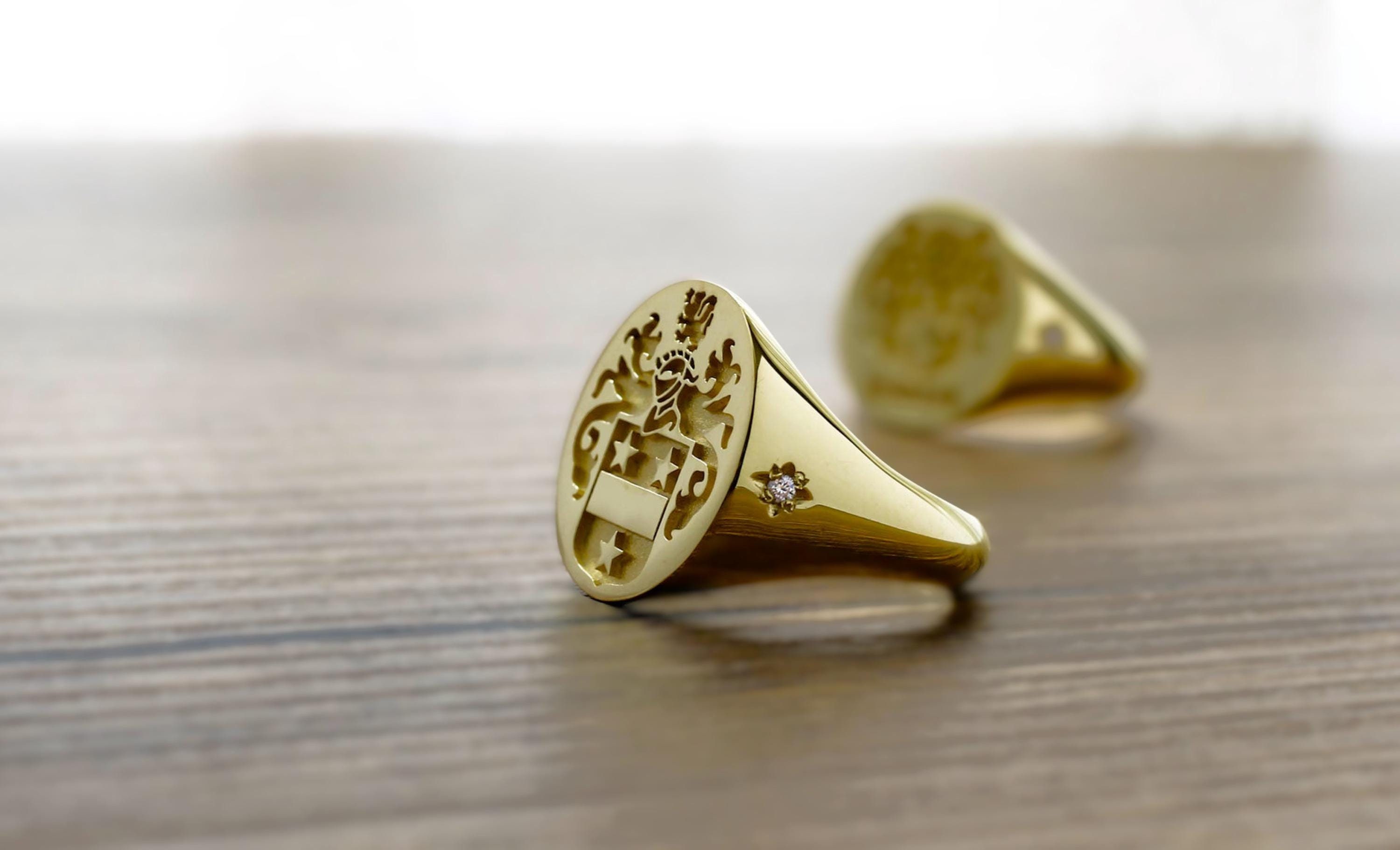
Unisex Appeal
Unlike some jewelry styles that are gender-specific, signet rings are worn by people of all genders. Men often opt for thicker bands with bold engravings (e.g., block initials), while women may prefer daintier bands with delicate symbols (e.g., a tiny heart or floral pattern). This inclusivity has helped boost their popularity in recent years.
Legacy and Heirloom Potential
Many people buy signet rings to pass down to future generations. A ring engraved with a family crest or monogram becomes a tangible link to the past, carrying stories and traditions from one family member to the next. This “heirloom quality” makes it a meaningful investment beyond just fashion.
Popular Styles of Signet Rings
While the classic signet ring design remains iconic, modern variations cater to diverse tastes—from traditional to minimalist, and bold to delicate.
Classic Crest Signet Ring
-
Features a family crest, coat of arms, or historical symbol engraved on an oval bezel.
-
Typically made of gold (14k or 18k) for a luxurious, timeless look.
-
Best for: Those wanting to honor family heritage or embrace traditional style.
-
Styling tip: Wear alone on the pinky finger (the classic placement) for a sophisticated vibe.

Monogram Signet Ring
-
Engraved with the wearer’s initials (usually 1–3 letters) in a classic font (e.g., serif, script).
-
Available in metals like sterling silver, gold, or rose gold.
-
Best for: Anyone wanting a subtle, personal accessory that’s easy to wear daily.
-
Popular variations: Stacked initials (for couples or families) or a single large initial for boldness.
Minimalist Signet Ring
-
Features a simple design: a plain bezel, a tiny symbol (e.g., a dot, line, or small star), or no engraving at all.
-
Made of thin bands (1–2mm) in sterling silver or white gold for a sleek look.
-
Best for: Minimalists or those who want to layer rings without overcrowding.
-
Styling tip: Pair with thin stacking rings for a modern, understated look.
Bold Statement Signet Ring
-
Has a large bezel (15mm+), thick band (3mm+), or eye-catching engraving (e.g., a large animal, intricate pattern, or colored enamel accents).
-
Often made of yellow gold or brass for a retro, bold feel.
-
Best for: Fashion-forward wearers who want their jewelry to stand out.
-
Styling tip: Wear alone on the index or middle finger to draw attention to the design.

How to Wear Signet Rings
Styling a signet ring is easy—its versatility means it works with almost any outfit, and placement can add extra meaning. Below are foolproof ways to wear this iconic piece.
Classic Pinky Finger Placement
-
The traditional spot for signet rings (rooted in historical use by nobility and businessmen).
-
For men: Wear a thick gold or silver signet ring on the dominant hand’s pinky (e.g., right pinky if right-handed) for a classic, authoritative look.
-
For women: Opt for a dainty monogram or minimalist signet ring on the pinky—pair with a thin band for subtlety.
-
Outfit ideas: Tailored suit, button-down shirt + chinos, or a little black dress.
Index or Middle Finger (Modern Twist)
-
A contemporary placement that feels fresh and fashion-forward.
-
Choose a medium-sized signet ring (bezel 10–12mm) for the index finger—great for showing off engravings.
-
For the middle finger: Pair a signet ring with 1–2 thin stacking rings on the same finger for dimension.
-
Outfit ideas: Crop top + high-waisted jeans, sweater + midi skirt, or a leather jacket + t-shirt.
Layered with Other Rings
-
Mix a signet ring with thin bands, midi rings, or gemstone rings for a trendy, personalized stack.
-
Tips for layering:
-
Use the same metal tone (e.g., all silver or all gold) for a cohesive look.
-
Place the signet ring on the middle finger, with smaller rings on the index and ring fingers.
-
Avoid overcrowding—stick to 3–4 rings total per hand.
-
Outfit ideas: Boho dress + sandals, casual t-shirt + shorts, or a blouse + wide-leg pants.
Formal Occasions (Elegant and Refined)
-
Opt for a gold or platinum signet ring with a classic engraving (e.g., crest or monogram).
-
Wear alone on the pinky or middle finger to avoid competing with other formal jewelry (e.g., earrings, necklaces).
-
Outfit ideas: Wedding gown, tuxedo, or a floor-length evening dress.
-
Pro tip: Pair with a matching gold watch or cufflinks for a polished, cohesive look.
Signet Rings: Perfect Gift for Your Wife
A signet ring is a thoughtful, meaningful gift for your wife—it’s personal, timeless, and something she’ll cherish for years (and maybe pass down). Here’s why it’s an ideal choice.
It’s Deeply Personal
Unlike generic gifts (e.g., flowers, jewelry boxes), a signet ring can be customized to reflect her personality:
-
Engrave her initials, your wedding date, or a symbol that represents your relationship (e.g., a heart, star, or the location of your first date).
-
Choose her favorite metal (observe her existing jewelry—does she prefer gold, silver, or rose gold?).
-
Pick a shape that suits her style (oval for classic, round for minimalist, rectangular for bold).
It’s Versatile and Wearable
She can wear it every day—whether she’s running errands, going to work, or attending a special event. Unlike delicate necklaces or earrings that may get damaged, a signet ring is durable enough for daily use (especially if made of sterling silver or gold).
It Symbolizes Your Bond
A signet ring engraved with a shared symbol (e.g., your initials stacked together, a meaningful date) becomes a tangible reminder of your love. It’s a way to say, “You’re part of my story, and I want the world to see that.”
Occasions to Gift It
-
Anniversaries: Perfect for 1st (paper, but a signet ring is a lasting alternative), 10th (tin / 铝,but gold feels more special), or 25th (silver) anniversaries.
-
Birthdays: A luxurious gift that feels indulgent but personal.
-
Mother’s Day: Engrave it with your children’s initials for a gift that honors her role as a mom.
-
Just because: Surprise her with a gift that shows you notice her style and value your relationship.
How to Clean Signet Rings
Signet rings (especially those made of precious metals) need regular care to stay shiny and in top condition. Below are easy cleaning methods based on metal type.
Daily Care Habits
-
Remove Before Activities: Take off the ring before washing dishes, showering, swimming, or applying lotion/perfume. Chemicals and water can tarnish metal or damage engravings.
-
Avoid Scratches: Don’t wear it during physical activities (e.g., gym, gardening) or while handling rough objects (e.g., tools, keys).
-
Store Properly: When not wearing it, keep it in a soft jewelry pouch or lined box—separate from other rings to prevent scratches.
Metal-Specific Cleaning Methods
-
Sterling Silver Signet Rings:
-
Mix 1 cup warm water with 1 teaspoon mild dish soap.
-
Soak the ring for 5–10 minutes to loosen dirt.
-
Gently scrub the engraving (use a soft-bristled toothbrush to reach crevices) and rinse with warm water.
-
Dry with a lint-free cloth, then polish with a silver polishing cloth to remove tarnish.
-
Gold (14k/18k) Signet Rings:
-
Mix 1 cup warm water with 1 teaspoon ammonia (or mild dish soap).
-
Soak the ring for 15 minutes.
-
Wipe with a soft cloth—avoid scrubbing (gold is soft and can scratch easily).
-
Rinse and dry thoroughly.
-
Platinum Signet Rings:
-
Use a platinum-specific cleaner (available at jewelry stores) or mix warm water with mild soap.
-
Gently wipe with a soft cloth—platinum doesn’t tarnish, so it just needs dust and dirt removed.
-
Avoid using abrasive cleaners (they can dull the metal’s shine).
Professional Cleaning
-
Have the ring professionally cleaned once a year (especially if it has intricate engravings or gemstones).
-
Jewelers can use ultrasonic cleaners to remove deep-seated dirt from engravings and check for loose settings (if the ring has stones).
What Is a Signet Ring in the Bible?
In the Bible, signet rings are mentioned multiple times as symbols of authority, power, and trust—often associated with kings, rulers, and important figures.
Key Biblical References
-
Genesis 41:42: Pharaoh gives Joseph a signet ring (along with a gold chain and royal robes) to appoint him as governor of Egypt. The ring symbolizes Joseph’s new authority to act on Pharaoh’s behalf—making decisions, signing documents, and governing the land.
-
Esther 3:10: King Ahasuerus gives his signet ring to Haman, his chief advisor, authorizing him to issue a decree to destroy the Jews. Later, in Esther 8:2, the king takes the ring back and gives it to Mordecai (Esther’s cousin), transferring authority to him to reverse the decree.
-
Jeremiah 22:24: The Lord tells Jeremiah that King Jehoiachin of Judah will be stripped of his signet ring—symbolizing the loss of his royal authority and status.
Biblical Symbolism
In biblical times, a signet ring was more than a piece of jewelry—it was a tool of governance. It represented:
-
Authority: Only those with power (kings, rulers, trusted advisors) wore signet rings, as they could use them to authenticate official decrees.
-
Trust: Giving someone a signet ring meant entrusting them with important responsibilities (like Joseph being trusted to govern Egypt).
-
Identity: The ring’s design (often a royal seal) identified the wearer as part of the ruling class or a trusted official.
What Does a Signet Ring Mean?
The meaning of a signet ring varies by wearer, but it often centers on identity, legacy, and personal values. Below are common interpretations.
For Individuals: Identity and Self-Expression
-
Personal Identity: Engravings like initials, symbols, or dates reflect the wearer’s personality, interests, or milestones. For example, a musician might wear a signet ring with a music note, while a new parent might have their child’s initials engraved.
-
Independence: Wearing a signet ring (especially on the pinky) can symbolize self-reliance or confidence—rooted in the historical association with self-made professionals.
For Families: Legacy and Connection
-
Family Heritage: A signet ring with a family crest or coat of arms honors ancestors and keeps family traditions alive. It’s often passed down from parent to child, becoming a tangible link to the past.
-
Unity: Couples may wear matching signet rings with stacked initials, while parents might have their children’s initials engraved—symbolizing their bond as a family.
Cultural and Historical Meanings
-
Status: In some cultures, signet rings still signify social or professional status (e.g., lawyers, bankers, or members of exclusive clubs may wear them).
-
Tradition: For many, wearing a signet ring is a way to embrace historical tradition—paying homage to the rings worn by kings, scholars, and leaders throughout history.
What Finger Do You Wear a Signet Ring On?
The finger you choose to wear a signet ring on can add extra meaning or style—here are the most common placements and their significance.
Pinky Finger (Classic Placement)
-
History: The traditional spot for signet rings, dating back to ancient Rome and medieval Europe. Nobility, businessmen, and officials wore them here to show status and authority.
-
Modern Meaning: Today, it’s a sophisticated choice that says “timeless” and “confident.” Men often wear thick gold or silver signet rings on their dominant hand’s pinky, while women opt for dainty styles.
-
Styling Tip: Wear alone on the pinky—avoid stacking other rings here, as it can look cluttered.
Index Finger (Bold and Modern)
-
Meaning: A contemporary placement that feels bold and fashion-forward. It’s great for showing off engravings, as the index finger is often used for gesturing (drawing attention to the ring).
-
Best For: Bold signet rings with large bezels or eye-catching designs (e.g., animal symbols, colorful enamel).
-
Styling Tip: Pair with a thin band on the same finger for extra detail, or wear alone for a statement.
Middle Finger (Balanced and Versatile)
-
Meaning: A neutral placement that works for both classic and modern styles. It’s balanced (not as bold as the index, not as traditional as the pinky) and great for everyday wear.
-
Best For: Medium-sized signet rings (bezel 10–12mm) with monograms or minimalist designs.
-
Styling Tip: Layer with 1–2 thin stacking rings on the same finger—mix metals for a trendy look.
Ring Finger (Sentimental)
-
Meaning: A sentimental choice, often used for signet rings with romantic or family-related engravings (e.g., wedding dates, children’s initials). It’s less common than the pinky or index but feels intimate.
-
Best For: Dainty signet rings in gold or rose gold—pair with a wedding band or engagement ring for a cohesive look.
-
Styling Tip: Wear on the non-dominant hand’s ring finger to avoid competing with a wedding band.
How to Make a Signet Ring
Making a signet ring is a craft that combines metalworking and personalization—whether done by a professional jeweler or a hobbyist with the right tools. The process focuses on shaping the band, creating the bezel (the engraved top), and adding custom details that make the ring unique. Below is a step-by-step breakdown of the professional method, plus tips for those interested in DIY.
Tools & Materials for Professional Making
-
Metal Blanks: Pre-cut pieces of sterling silver, gold, or brass (the base for the band and bezel). Band blanks come in different widths (2mm–5mm) to match the desired thickness.
-
Metalworking Tools: A jeweler’s saw (to cut the blank to size), a file (to smooth edges), a mandrel (a cylindrical tool to shape the band into a ring), and pliers (round-nose and flat-nose for bending metal).
-
Engraving Tools: A graver (a sharp tool for hand-engraving) or a laser engraver (for precise, detailed designs like monograms or crests). For hand-engraving, a magnifying glass or bench peg (to hold the ring steady) is essential.
-
Finishing Supplies: A torch (for soldering the band closed), pickle solution (to clean solder marks), sandpaper (various grits for smoothing), and a polishing wheel (to add shine).
Step-by-Step Professional Process
-
Size the Band:
-
Measure the wearer’s finger (use a ring sizer for accuracy) to determine the band circumference.
-
Cut a metal blank to the required length, leaving a small overlap (2–3mm) to solder the ends together.
-
File the cut edges to ensure they’re flat and even—this helps the band close securely when soldered.
-
Shape the Band:
-
Slide the metal blank onto a mandrel, aligning it with the correct ring size mark.
-
Use a mallet to gently tap the blank around the mandrel, shaping it into a circular band. Rotate the blank as you tap to ensure it’s even (no lopsided curves).
-
Solder the overlapping ends of the band closed: Heat the joint with a torch until the solder melts and flows into the gap, then quench the ring in water to cool it.
-
Create the Bezel:
-
Cut a small, flat piece of metal (matching the band’s material) for the bezel. Common shapes are oval (10mm–15mm long) or round (8mm–12mm wide)—trace a template if precision is key.
-
File the bezel’s edges to smooth them, then solder it to the top of the band. Position it centered on the band, ensuring it’s straight (use a ruler to check alignment before soldering).
-
Quench the ring again and soak it in pickle solution for 10–15 minutes to remove oxidation from soldering.
-
Engrave the Design:
-
Sketch the desired design (monogram, crest, symbol) onto the bezel with a pencil—use a light touch to avoid scratching the metal.
-
For hand-engraving: Hold the ring steady on a bench peg, then use a graver to carve the design into the bezel. Work slowly, following the sketch, to ensure clean lines.
-
For laser engraving: Upload the design to a laser engraver, secure the ring in the machine, and let the laser etch the pattern—this is ideal for intricate details or precise text.
-
Finish the Ring:
-
Sand the band and bezel with sandpaper (starting with 400-grit, then moving to 800-grit and 1200-grit) to smooth any rough spots or solder marks.
-
Polish the ring with a polishing wheel (use a soft buffing pad for gold or silver) until it has a bright, even shine. For a matte finish, skip the final polish and use a wire brush instead.
-
Inspect the ring for flaws: Check that the band is comfortable (no sharp edges), the bezel is secure, and the engraving is clear. Make adjustments (e.g., re-filing edges) if needed.
DIY Tips for Hobbyists
-
Start Small: If you’re new to metalworking, begin with a pre-made ring blank (available at craft stores) instead of cutting metal from scratch. This simplifies the band-shaping step.
-
Use Hand Engraving Kits: Affordable beginner kits include a basic graver, bench peg, and practice metal pieces—perfect for learning to carve simple monograms before working on a real ring.
-
Avoid Soldering First: For DIY, try a “cold-connection” band (using a jump ring or clasp to close the band) instead of soldering—this eliminates the need for a torch and reduces the risk of mistakes.
-
Seek Professional Help for Precious Metals: If using gold or platinum (soft, expensive metals), have a jeweler handle soldering and engraving—these materials require precision to avoid wasting metal or ruining the design.
Conclusion: Wear Your Story with a Signet Ring
Signet rings are more than just jewelry—it’s a wearable narrative of who you are, where you come from, and what matters most. With searches for signet rings rising 91% year-over-year (per the 2024 Global Fine Jewelry Report), it’s clear this timeless piece resonates with modern shoppers craving meaning in their accessories. Whether you opt for a classic crest design, a monogrammed everyday style, or a bold statement piece, a signet ring adapts to your life: it’s there for work meetings, family dinners, and milestone moments, carrying your story with every wear.
Ready to own a signet ring that’s uniquely yours? Start by defining what matters most: Do you want to honor family heritage with a crest? Celebrate a milestone with a date engraving? Or keep it simple with your initials? Next, choose a metal that fits your style (sterling silver for affordability, gold for luxury, rose gold for warmth) and a finger placement that feels right (pinky for tradition, index for boldness). For a truly one-of-a-kind piece, work with a local jeweler to handcraft the ring—they can guide you through sizing, engraving, and finishing to ensure it’s perfect.
Don’t wait to wear your story. A signet ring isn’t just an accessory—it’s a legacy in the making. Start your journey today, and soon you’ll have a piece that not only elevates your style but also connects you to the moments, people, and values that make you you.






